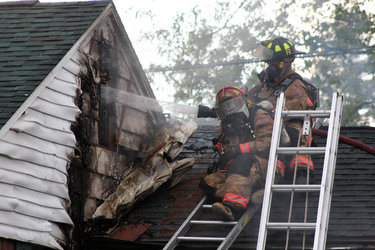Towns and schools discuss property tax breaks for vets and volunteer first responders
GUILDERLAND — Finding and keeping volunteers has become such an issue for the Guilderland Fire Department that it created a new position for a recruitment and retention officer.
“It all goes towards recruitment and retention, which has kind of been a hidden bugaboo of the volunteer fire department for a number of years,” Donald Gaitor, a 50-year volunteer firefighter, told Guilderland Town Board this month.
Gaitor was at the town board meeting along with other firefighters on Jan. 17 to speak in favor of a proposed local law that would give volunteer first responders a break on their town property taxes.
The board will hold a public hearing on the local law on March 21, at 7 p.m.
Meanwhile, the Voorheesville School Board at its January meeting discussed doubling the exemption veterans receive on their property tax bill.
Guilderland proposes town tax break
Last year, Governor Kathy Hochul signed into law a bill that allows local taxing jurisdictions to offer a property tax break to volunteer firefighters and volunteer ambulance workers.
At the Jan. 17 Guilderland Town Board meeting, Supervisor Peter Barber said, “The goal of the legislation is to provide an incentive for both getting more volunteers, but also retaining members.”
The state legislation enables taxing jurisdictions to provide up to a 10 percent exemption for a period of between two and five years for volunteer first responders whose primary residence is located in that jurisdiction, Barber said.
Albany County has a law on its books that is “substantially the same” as Guilderland’s proposed first law of 2023, Barber told board members, and is using a two-year term. But, he said, “What gets complicated very quickly, or maybe ambiguous very quickly, is that the state then says each taxing jurisdiction has to set forth the procedure by which eligibility will be determined.”
Guilderland’s local law is based on the county’s law, which is based on the amount of service a volunteer has, which in turn is based on a point system of activities performed by firefighter or member of an ambulance corps.
The sticky wicket is that, since the “state legislation didn’t say what criteria to use” when determining eligibility,” Barber said on Jan. 17, municipalities have to come up with their own criteria — the point system is based entirely on the firefighters’ service award program.
“I don’t know if we have any volunteer ambulance workers,” Barber said.
In Albany County in 2022, just one firefighter tax exemption was granted, in Coeymans, according to assessment roll data submitted to the state Department of Taxation and Finance; statewide, about 9,500 volunteer first responders received exemptions.
The earliest the program could go into effect would be March 2024.
Councilwoman Rosemary Centi said volunteers would be eligible for either a 10-percent property-tax abatement or 10-percent income-tax credit. They “would not be able to get both,” she said, recounting her conversation with the town’s assessor. “It’s not a great savings unless the school districts and towns are on board along with the county,” Centi said.
It’s a time-consuming process, Centi said of tracking the volunteers’ service time. And there still has to be a way to monitor the years of service and active service within each department, “along with that they are not receiving the tax credit on your [tax] returns,” she said.
Michael Dempsey, the chairman of the Town of Guilderland Chiefs Association, was asked by Barber if the service award program was the best metric to use when judging eligibility for a tax break.
Barber said the firefighters’ service award looked like a defined-benefit program, or pension. “Is that considered to be the best measure, you think, for applying here for real property exemption?” he asked “Or is there some other criteria you think might be appropriate?”
Dempsey told Barber the policy the board is considering “pretty much is what every district will utilize to determine whether or not someone has maintained an active volunteer status in the town. So, if they don’t meet that criteria, then they aren’t really an active volunteer firefighter. And I don’t think you’d want to give anyone who’s not an active volunteer firefighter that type of tax exemption.”
He continued, “But if they have met that criteria, that means they’re active in your community, they’re going to calls, they’re going to drills, they’re doing their time. And so I think it is a good measure of making sure you’re giving it out to active volunteer firefighters.”
Barber thanked Dempsey and said he was glad Dempsey made such a distinction in his answer, “because it really is the act of nature of the commitment.”
Councilman Jacob Crawford asked Dempsey if the tax break was part of recruiting more volunteers, and was told it was. Crawford then asked Dempsey to estimate the active number of firefighters Dempsey had currently, five years ago, and 10 years ago.
Dempsey said there are currently about 30 active firefighters in his district, the Guilderland Fire Department, but he didn’t have historic numbers. Eric Adams, the chief of the Fort Hunter Volunteer Fire Company, told the board active membership in his department had hovered around 50 firefighters for the past two decades.
VCSD mulls school tax break
Voorheesville is considering the volunteer first-responder tax break, but the topic was only touched on at the Jan. 9 school board meeting, where the focus was on the tax break for veterans.
Dempsey told Guilderland Town Board members he’d already brought the local law to the Bethlehem School Board for consideration. The first-responder exemption, according to agendas and meeting minutes, does not appear to have been a topic of discussion yet for the Guilderland Central School District.
The break veterans receive on their Voorheesville school taxes has been around since 2013, when the state legislature expanded existing property tax law in effect since the 1980s that applied to counties, cities, towns, and villages.
The state legislation authorizing the exemptions allowed municipalities to pass local laws and school districts to adopt resolutions to use two sets of lower exemption limits or 21 sets of higher limits, with caps that top out at $75,000, $125,000, and $250,000.
When the Voorheesville School Board adopted the 2016 resolution that put into place the current exemption, 274 district residents became eligible for the tax break.
There are three levels of exemption: wartime veteran, combat veteran, and disabled veteran. Seven years ago, the district set the exemption at the “lowest amount it could be,” Assistant Superintendent for Finance and Operations James Southard told board members on Jan. 9: $6,000 for a wartime veteran, $10,000 for a combat veteran, and $20,0000 for a disabled veteran.
The discussion about increasing the exemption came about because one veteran resident had his status changed to disabled, board members were told.
The base-level increase, as Southard referred to it, would bring Voorheesville up to the New York State basic maximum, which he called Level A, doubling the current exemption: $12,000 for a wartime veteran, $20,000 for a combat veteran, and $40,000 for a disabled veteran.
The current aggregate veteran exemption amounts to about $350,000, meaning that money gets taken off tax bills for veterans who live in the district and is paid instead by the remaining taxpayers.
Southard estimated the impact of the tax break increase would be “roughly 2 percent,” he said. “So that’s a more significant impact, approximately 32 cents per [$1,000] true value.”
Southard explained the district’s “true value” tax rate this year is about $16 per $1,000 assessed value, meaning that, although the tax rate per $1,000 of assessed value is about $20.25 in New Scotland, $18 in Guilderland, and about $33 in Berne, the uniform percentage that each municipality is multiplied by — set by the state at 81, 91, and 50 percent respectively — gets those numbers to approximately $16 per $1,000.
That 32 cents per $1,000 would be added to every tax bill in the school district; so the additional estimated total dollar value that the school district’s other taxpayers would have to pick up for its veteran residents would be about $400,000. “That would be a savings for the veterans that would be added on the taxes of everyone else,” Southard said.
Voorheesville’s tax levy is about $19.75 million.
As of 2022, according to assessment-roll data submitted to the New York State Department of Taxation and Finance, there were about 335 Voorheesville School District properties receiving some kind of veteran exemption.
If the school board were to adopt the additional tax break, the 2-percent increase, or additional 32 cents per $1,000, would be spread across the rest of the district, putting the new “true value” at about $16.32 per $1,000 assessed value.
Board members were cognizant of their delicate situation as they discussed decreasing bills of a few while increasing taxes for many. No one wanted to come off as speaking ill of the district’s veterans, but members acknowledged they would effectively be signing off on an increase to a lot of people’s taxes without them having a say in the matter.
Perhaps the issue was better suited for the voting booth, board member Patricia Putnam said. “Since it’s like a tax increase,” Putnam said, “it seems odd for us to decide.”
Southard responded, “That’s kind of the issue, it’s not really a tax increase so that the state doesn’t consider it that. I personally have not seen school districts do that,” he said of the idea of putting the exemption increase on the ballot and letting residents decide.
Board member Tim Kremer pointed out that, when the law was first put in place, there was a lot of “political hubbub” and energy at the state level, because the legislators who’d passed the bill did not have to deal with implementing it, or the fallout that would come from municipalities and school districts having to debate putting in place the benefit.
The Voorheesville discussion soon petered out and the board moved on to other issues.
The board has until March 1 to decide on whether to allow the increase.



